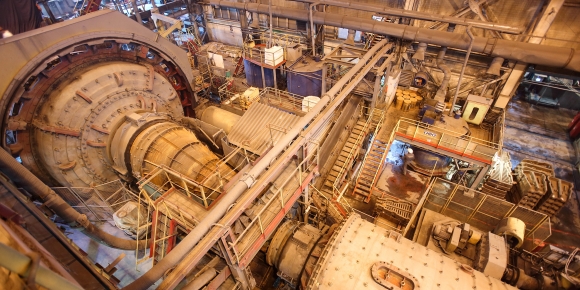In a recent conference call, Russia’s gold mining leader Polyus outlined in depth some of the technology it has implemented or is implementing to optimise its operations, which includes everything from equipment modernisation and retrofitting to increased throughput capacities and recoveries, to application of more fully automated control systems. Polyus’ key assets (the Krasnoyarsk cluster and Natalka) are among the top 15 globally by reserves and production; while the company also states that it is the lowest cost producer among the top ten gold miners, and technology application has been a big part of this. Output was 1.968 Moz in 2016.
Numerous optimisation examples were given. At Verninskoye, a new Metso HP300 crushing unit has increased ore crushing capacity by 10% in the circuit. A new carbon depressant for flotation increased recovery rates in hydrometallurgical cycles by 2.5%; and the introduction of oxygen to the CIL process improved leach kinetics and increased recovery in the CIL cycle by 3%. Automation of reagent solution preparation stabilised reagent quality and replaced manual labour with a cheaper alternative. Finally, the introduction of inner liners for auxillary equipment reduced downtime by 70 hours per year with the utilisation rate increased by 2%.
At Blagodatnoye, new Weir Minerals Warman pumps have allowed for higher treatment capacity (pulp flow increased by 286 m3/hour) and have lower wear-and-tear/downtime. At Olimpiada the fully automatic control of processing equipment improved operating parameters, with bio-oxidation (BIO) throughput increasing from 850-900 t/d to 1,110 t/d. Olimpiada also saw the introduction of lube oil systems for the ore crushing unit reducing its downtime by more than 50%. Polyus originally developed its BIONORD bio-oxidation technology in-house to best fit the chemical parameters of the refractory ore at Olimpiada. BIO at Polyus now yields 93% gold recovery from flotation concentrate, while the alternative method – direct cyanidation – only yields 30-40%.
Polyus has also made a major effort to apply a Mine-to-Mill approach ie optimising the comminution process from ROM ore to the final concentrate. This includes achieving an even particle size distribution with increased yield of fines; increasing primary crushing capacity through blasting fragmentation; increasing metal quantity with minimum increases in losses; and drilling and blasting according to the updated ore domain model. A Mine-to-Mill trial at Blagodatnoye in April 2017 demonstrated its effectiveness and Polyus is working on a full roll out of the Mine-to-Mill project at Blagodatnoye and Verninskoye form 2018.
Flash flotation is another technology focus, with an Outotec SkimAir unit installed at Mill 4 with an additional unit due to be installed on the back of successful results achieved. Further flash flotation units have been ordered for delivery and installation at Mills 1, 2 and 3. In addition there is a unit running in testing mode at Verninskoye. Key benefits include minimised overgrinding, improved recovery and improved dewatering.











